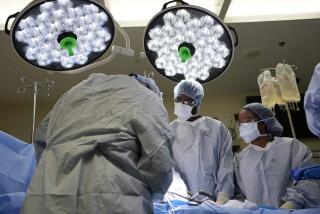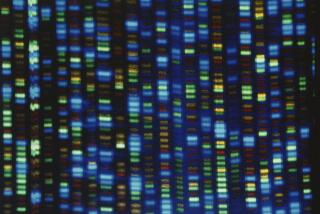A New Source of Hope
- Share via
Theresa and Scott LaRue thought they had four healthy boys until their son Layne contracted Epstein-Barr virus in 1994 and died within two weeks. Trying to understand why Layne suffered such a drastic outcome from a viral infection that is normally much milder, physicians quickly discovered that two other sons--Garrett, then 3 1/2, and Blayke, 6 months--both have severely impaired immune systems.
“It came out of nowhere for us,” said Theresa LaRue. “Within a couple of days, our lives were just completely destroyed.”
Six weeks of tests and intensive study revealed that both boys suffered from X-linked lymphoproliferative syndrome (XLP), a genetic immune deficiency that leaves them exceptionally vulnerable to viruses like Epstein-Barr and other infections.
One possible treatment for their disorder was a bone marrow transplant, but a search yielded no compatible donors. Their physician then recommended that they contact Dr. E. Richard Stiehm of UCLA, who was conducting an experimental program using cord blood--collected from the umbilical cord and placenta after childbirth--as a donor source.
Cord blood is the residual blood that is contained in the umbilical cord and placenta after birth. Collecting it does not require any changes in the birthing process and does not affect either the mother or the infant.
Normally, the umbilical cord is clamped off to prevent blood flow before it is severed from the infant. Then the placenta, or afterbirth, and the cord are discarded.
Stiehm was able to find a close enough match from frozen blood at the UCLA cord blood bank and performed transplants on both boys, first Garrett and then, a year later, Blayke. He reported two weeks ago in the Journal of Pediatrics that both boys are now healthy and attending school and have suffered no serious infections.
“Their bodies have worked absolutely perfectly,” said Theresa LaRue. “We’re absolutely ecstatic.”
Bone marrow transplants are becoming increasingly common, not only as a treatment for cancer, but also as a potential cure for genetic disorders such as XLP and sickle cell disease. An estimated 20,000 bone marrow transplants are performed each year, according to Dr. John Fraser, head of the UCLA cord blood bank.
But at any one time, there are usually about 3,000 people looking for a donor. That search can take nine months or more, delaying potentially life-saving treatment. Many people, especially members of minority groups, never find suitable donors. The shortage of donors has led to several highly publicized cases in which parents have conceived a child to serve as a donor for a child who was sick.
Cord blood represents a potential solution in many such cases. It also is a potentially noncontroversial alternative to aborted fetuses as a source of stem cells for other procedures, including the treatment of Parkinson’s disease and strokes. It is also potentially useful in regenerating damaged heart muscle.
“It’s amazing to think that when a baby is born, a new life comes into the world along with a chance to save other lives,” LaRue said.
When the cord blood is to be collected from a newborn, the placenta and cord are taken into an adjoining room where all the blood is allowed to drain into a plastic bag filled with anticoagulant to keep it from clotting. The blood is tested for viruses, then frozen at liquid nitrogen temperatures.
Ease of collection is just one of the advantages of cord blood. Accessibility is another. Because it is banked, surgeons seeking a donor can search quickly for a compatible specimen. When one is found, it can be shipped out immediately and be available for an implant the next day.
Cord blood is also less likely than bone marrow to trigger graft-versus-host disease, in which the transplanted immune system attacks the recipient’s tissues. Researchers are not completely sure why cord blood is safer. But part of the reason is that the immune cells have not been exposed to many foreign chemicals--or antigens--during their short life.
Cord blood transplantation also works with a less-than-perfect match. There are six major antigenic sites--markers that identify tissue for the immune system. For bone marrow, a match at all six can be crucial. For cord blood, five of six is sufficient. Both Blayke and Garrett received cord blood that matched at only five sites, with no significant problems.
Some researchers, such as Dr. Alexandra H. Filipovich of Children’s Hospital Medical Center in Cincinnati, say the procedure could work if there is a match at four of the six antigenic sites, perhaps even with three of six.
An estimated 1,500 cord blood transplants have been performed around the world--about 40 of them for genetic disorders like Blayke’s and Garrett’s. The procedure is still considered experimental, however, and has not been fully approved by the Food and Drug Administration, pending the completion of several clinical trials.
To boost research on cord blood, the National Institutes of Health in 1995 established national cord blood banks, choosing UCLA and Duke University to initiate the program. Since 1997, those two sites have collected and stored about 15,000 cord blood samples. Roughly 100 of them have been used for transplants so far, Fraser said.
Stored cells from those banks are given out for free, but only to researchers who are participating in certain federally funded clinical trials of cord blood transplants. The UCLA bank, in particular, has a large number of samples collected from ethnic minorities, but they are not available to the people who could best use them.
“We have more Chinese cord blood than most banks in China and Taiwan, for example,” Fraser said. “Yet they can’t search my bank. It’s a little frustrating.”
People not enrolled in federal studies must turn to commercial blood banks, which generally operate on one of two business plans. Some, such as Cord Blood Registry in San Bruno, solicit parents to store blood in case their children later develop a disease for which it is needed.
Cord Blood charges parents $1,290 for collection of the blood and another $95 per year for storage. But critics charge that this is not a very good investment. Only about one in every 10,000 children develops a condition for which cord blood would be useful. And most physicians argue that cord blood from an unrelated donor will probably be more effective in most cases than the child’s own cord blood.
Other companies, such as StemCyte Inc. in Arcadia and the New York Blood Center, collect donations, then sell cord blood to people looking for a donor. The New York Blood Center charges $15,600, “and they make a loss on every one of them,” Fraser said.
“That’s a very fair price,” Stiehm added, because only about one in every 10 samples collected ever gets used.
Placentas could become even more valuable in the future. Anthrogenesis Corp. of Cedar Knolls, N.J. announced last week that it has devised a technique for getting stem cells from the placenta itself, isolating perhaps 10 times as many stem cells as are available in cord blood.
For further information: https://www.cordblood.med.ucla.edu; https://www.cordblood.com; https://www.stemcyteinc.com
Maugh can be reached at [email protected]






